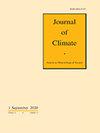海洋复杂性塑造了 CESM2 耦合模型层次结构中的海表温度变异性
IF 4
2区 地球科学
Q1 METEOROLOGY & ATMOSPHERIC SCIENCES
引用次数: 0
摘要
摘要 为了更好地了解海洋过程对海面温度月变化的影响,我们分析了共同体地球系统模式第 2 版的层次结构,其中的模式仅在海洋复杂程度上有所不同。最现实的海洋是动力学海洋模式,是完全耦合模式(FCM)的一部分。其次是机械解耦模式(MDM)中最逼真的海洋,与全耦合模式类似,但不包括风应力驱动的海洋异常变化。最简单的海洋是板块海洋模式(SOM)。与 SOM 相比,在 MDM 中加入浮力耦合动力海洋,包括 SOM 中没有的温度平流和垂直混合,会抑制各地的 SST 变异,并降低高纬度和赤道太平洋地区 SST 异常的持续性。与 MDM 相比,在 FCM 中加入风应力驱动的海洋动力异常会导致大部分地区的 SST 变差增大,持续时标变长。动态海洋作为异常海温变异和持续性的总体抑制器或放大器,其净作用与区域有关。值得注意的是,我们发现,在 SOM 和 MDM 配置中,降低海洋模式复杂性的努力导致 SST 变率的热动力作用力大小与 FCM 相比发生了变化。这些变化部分源于季节性变化的混合层深度的差异,在试图量化某些海洋机制对模型间 SST 变率差异的相对贡献时应加以考虑。本文章由计算机程序翻译,如有差异,请以英文原文为准。
Ocean Complexity Shapes Sea Surface Temperature Variability in a CESM2 Coupled Model Hierarchy
Abstract To improve understanding of ocean processes impacting monthly sea surface temperature (SST) variability, we analyze a Community Earth System Model version 2 hierarchy in which models vary only in their degree of ocean complexity. The most realistic ocean is a dynamical ocean model, as part of a fully coupled model (FCM). The next most realistic ocean, from a mechanically decoupled model (MDM), is like the FCM but excludes anomalous wind stress-driven ocean variability. The simplest ocean is a slab ocean model (SOM). Inclusion of a buoyancy coupled dynamic ocean as in the MDM, which includes temperature advection and vertical mixing absent in the SOM, leads to dampening of SST variance everywhere and reduced persistence of SST anomalies in the high latitudes and equatorial Pacific compared to the SOM. Inclusion of anomalous wind stress-driven ocean dynamics as in the FCM leads to higher SST variance and longer persistence timescales in most regions compared to the MDM. The net role of the dynamic ocean, as an overall dampener or amplifier of anomalous SST variance and persistence is regionally dependent. Notably, we find that efforts to reduce the complexity of the ocean models in the SOM and MDM configurations result in changes in the magnitude of the thermodynamic forcing of SST variability compared to the FCM. These changes, in part, stem from differences in the seasonally varying mixed layer depth and should be considered when attempting to quantify the relative contribution of certain ocean mechanisms to differences in SST variability between the models.
求助全文
通过发布文献求助,成功后即可免费获取论文全文。
去求助
来源期刊

Journal of Climate
地学-气象与大气科学
CiteScore
9.30
自引率
14.30%
发文量
490
审稿时长
7.5 months
期刊介绍:
The Journal of Climate (JCLI) (ISSN: 0894-8755; eISSN: 1520-0442) publishes research that advances basic understanding of the dynamics and physics of the climate system on large spatial scales, including variability of the atmosphere, oceans, land surface, and cryosphere; past, present, and projected future changes in the climate system; and climate simulation and prediction.
 求助内容:
求助内容: 应助结果提醒方式:
应助结果提醒方式:


